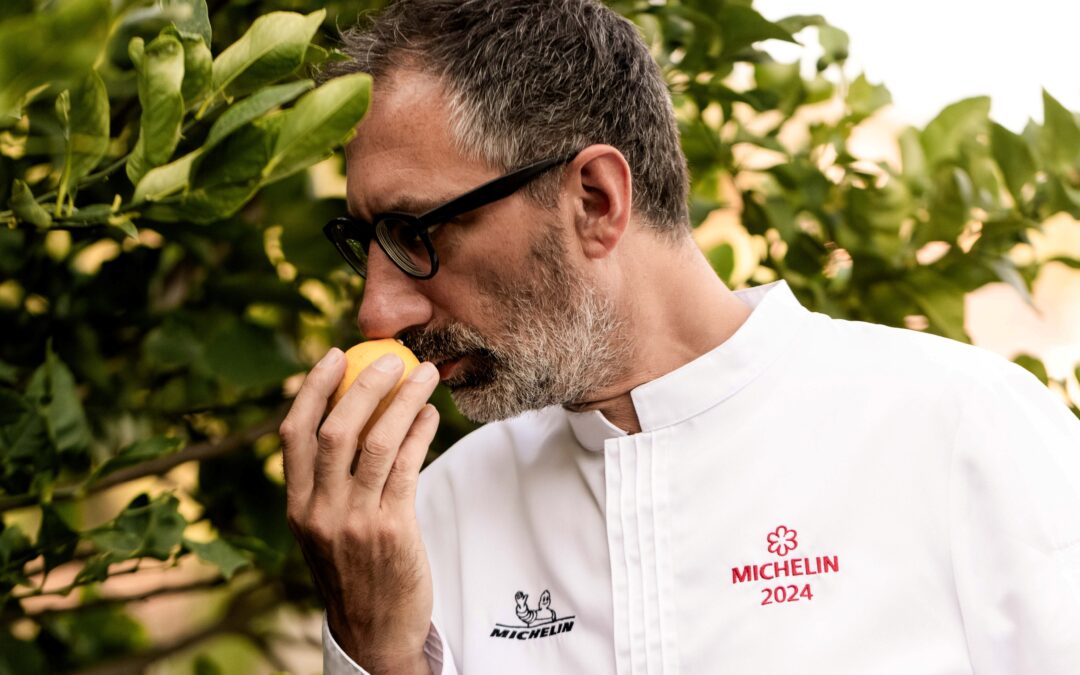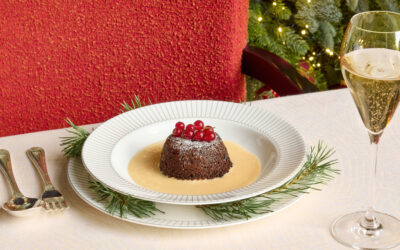Born in Molfetta (Bari) in 1977, Maurizio Bufi has always known he wanted to be a chef. After hospitality school, he began accumulating a long series of work experiences, first on Lake Como and cruise ships, then in Switzerland. Upon returning to Italy, he decided to pivot his career, arriving on the shores of Lake Garda and dedicating himself to exploring lake cuisine.
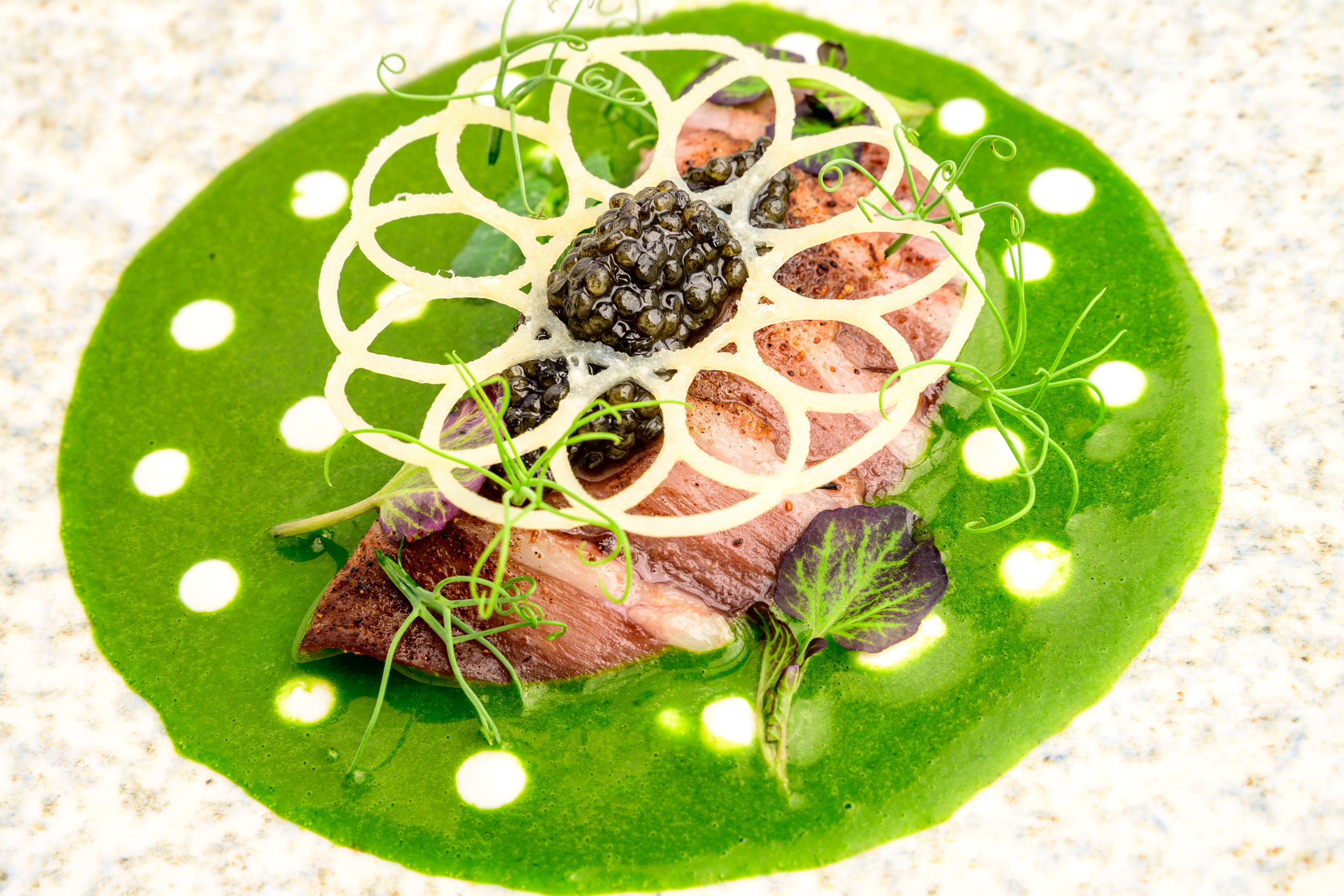
Goose pastrami, caviar, tubers and watercress
Following a brief period working at Lefay Resort & Spa in Gargnano, in 2012 he moved to Villa Giulia, where he earned 1 Michelin Star in 2017. Finally, in 2021, he joined the large family of the 5*L Grand Hotel Fasano. This is where he currently manages the Il Fagiano restaurant, which, thanks to its Mediterranean-inspired cuisine that is creative and full of personality, was awarded 1 Michelin Star in November 2023.
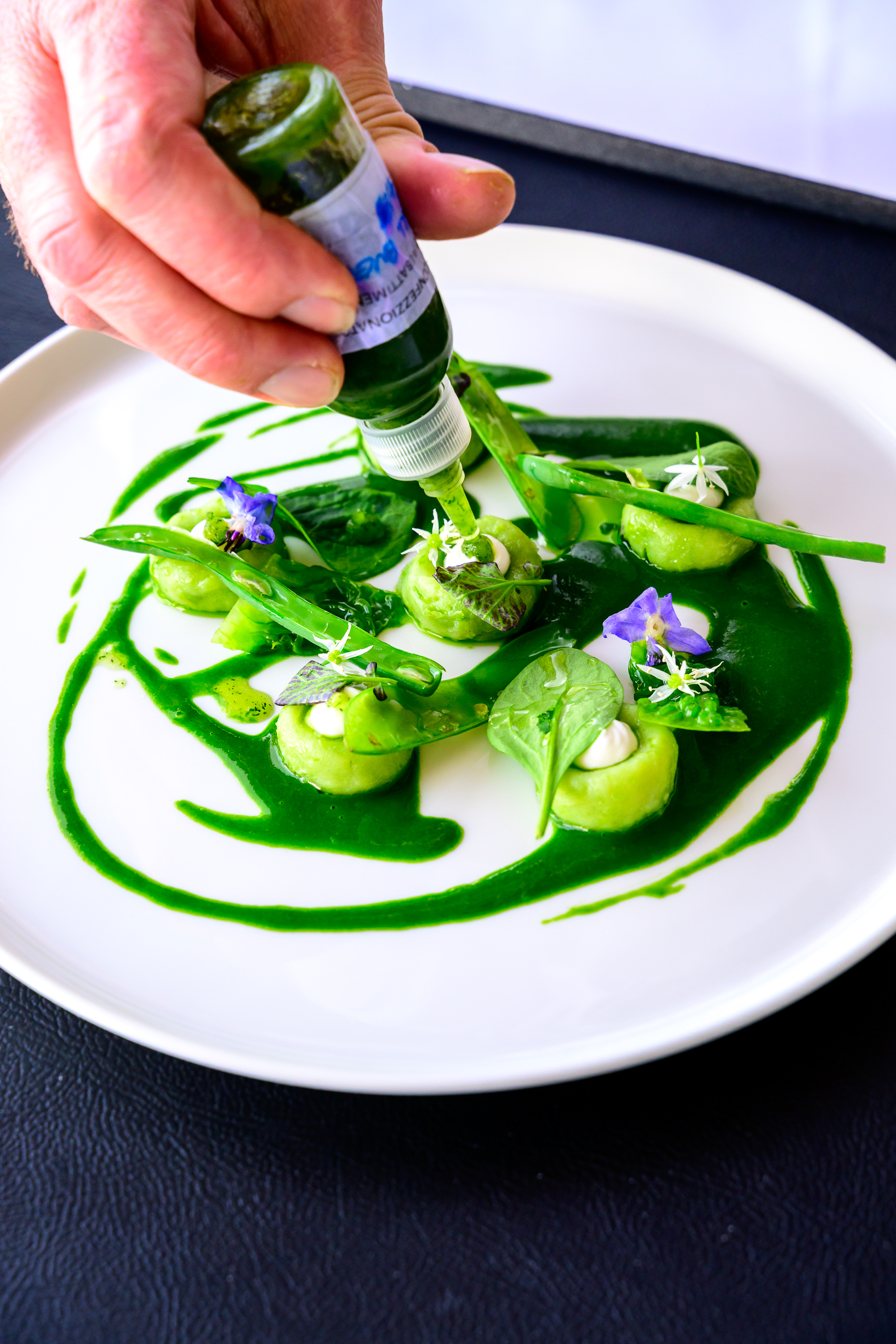
Dumplings “GREEN”
Do you have a favourite time of the year or set of ingredients that you look forward to working
with?
Ah, what a good question! I don’t have seasonal preferences, but I can say that each season brings with it fascinating ingredients. For example, spring with its abundance of fresh herbs and edible flowers is perfect for delicate and fragrant dishes. Autumn, on the other hand, offers chestnuts, mushrooms, and pumpkin—a true feast for rich and enveloping flavours. These for me are the most interesting seasons: spring and autumn that pave the way and create interesting dishes.
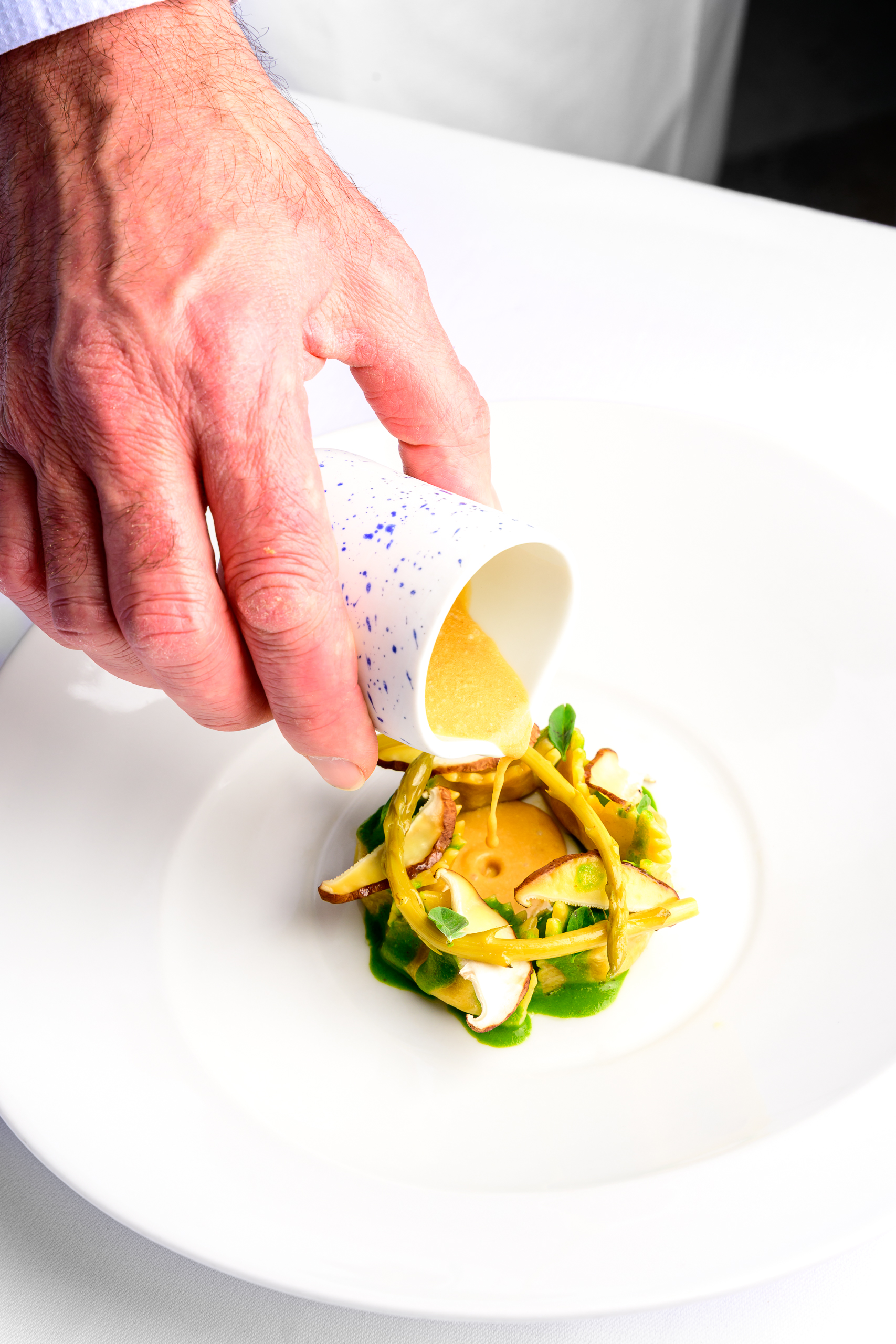
Rabbit plin, shiitake mushrooms and barley miso
What would you do if you weren’t a chef?
If I weren’t a chef, I could be an artist who creates masterpieces with colours and shapes, just as I do with ingredients and flavours. Or, I could be an explorer, traveling the world in search of new culinary traditions and captivating stories. Who knows, maybe I’d be a composer who transforms emotions into music, just as I transform simple elements into extraordinary dishes.
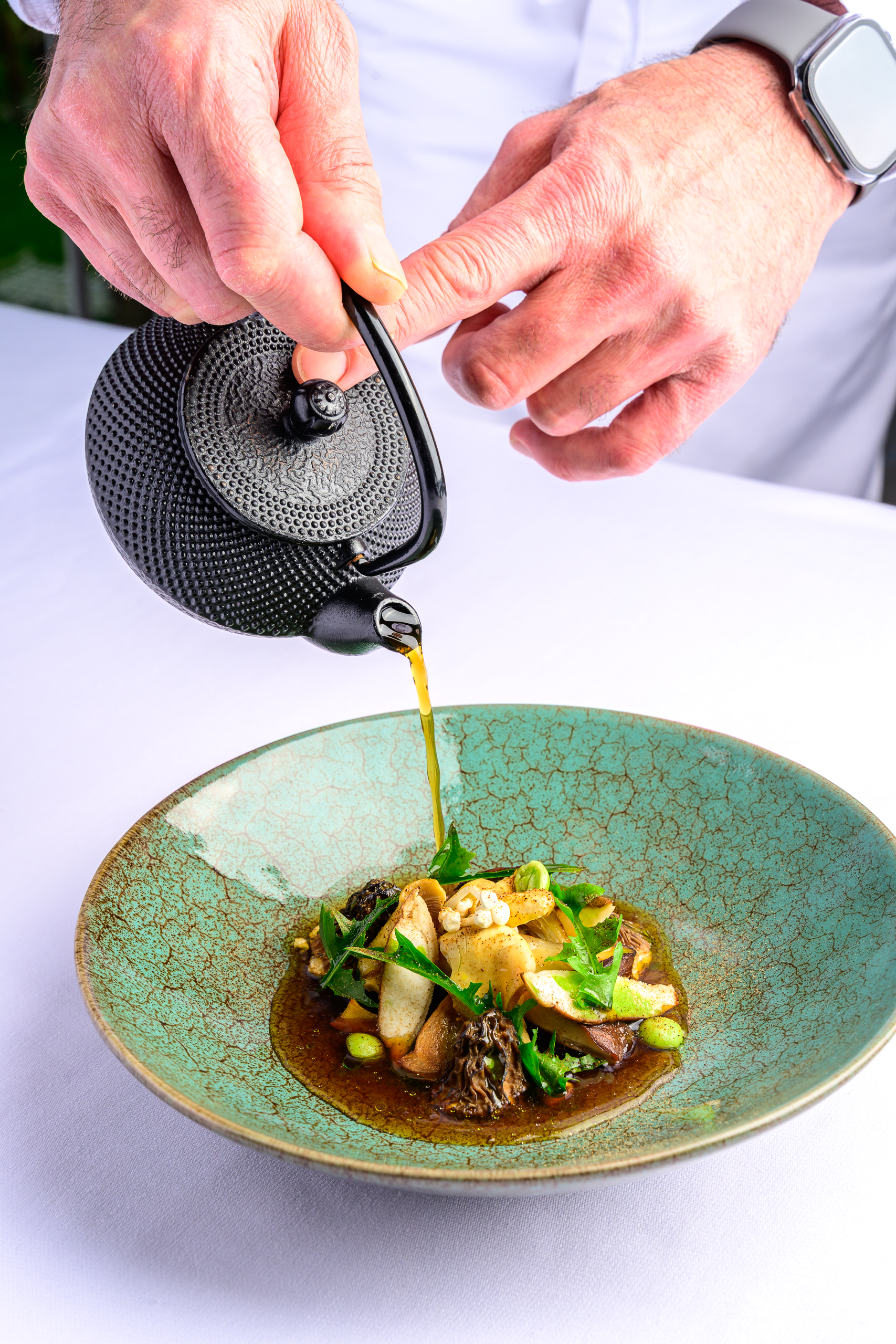
Variation of mushrooms
Do your personal preferences influence the menu at all?
Absolutely ! Every chef carries a baggage of experience, tastes, and sensitivity that inevitably influence their creations. Even if a good menu must reflect diversity and satisfy a wide range of palates, there is often a personal signature in every dish—a beloved ingredient, a favourite technique, or a creative touch that makes everything unique. There are certainly flavours we enjoy more than others, perhaps linked to childhood memories or unforgettable journeys. Even the mood of the moment can play a role: some days inspire bold and complex dishes, while others lead towards simplicity and comfort food.
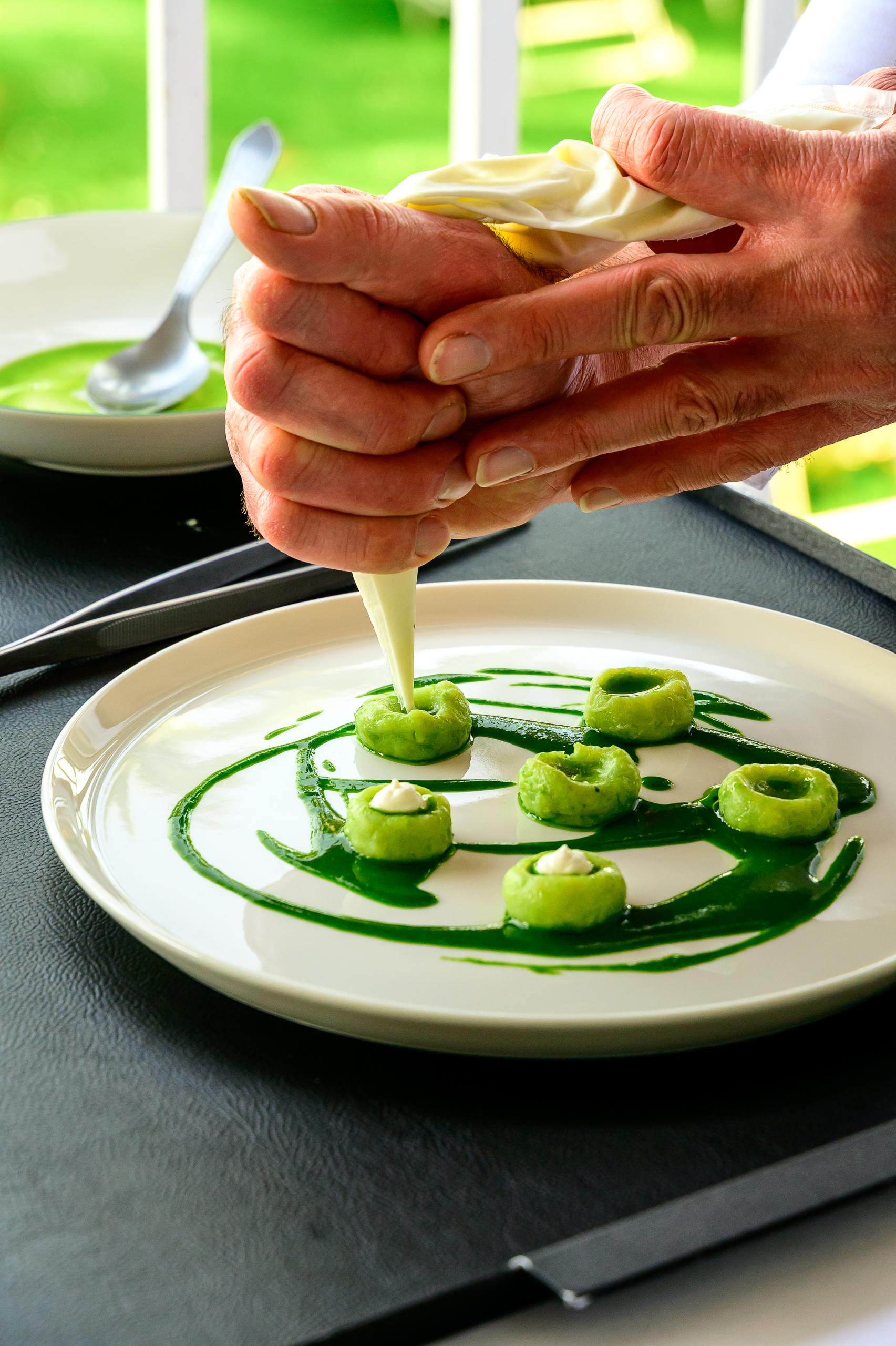
Dumplings “GREEN”
What do you think is the most over-hyped food trend currently?
There are always culinary trends that capture attention and become omnipresent, but not all of them deserve the hype they receive. One of the most overrated trends could be the excessive use of exotic ingredients or ultra-sophisticated techniques just to amaze, rather than to enhance the authentic flavour of the dish. Often, one sees the obsessive search for uniqueness at the expense of balance and genuineness. Or, one could talk about the continuous reinvention of “gourmet” versions of simple dishes—like sandwiches or pizza—that sometimes lose their essence in the race for extreme innovation. Don’t misunderstand me, evolution is fundamental, but some trends seem more a matter of marketing than real culinary progress.
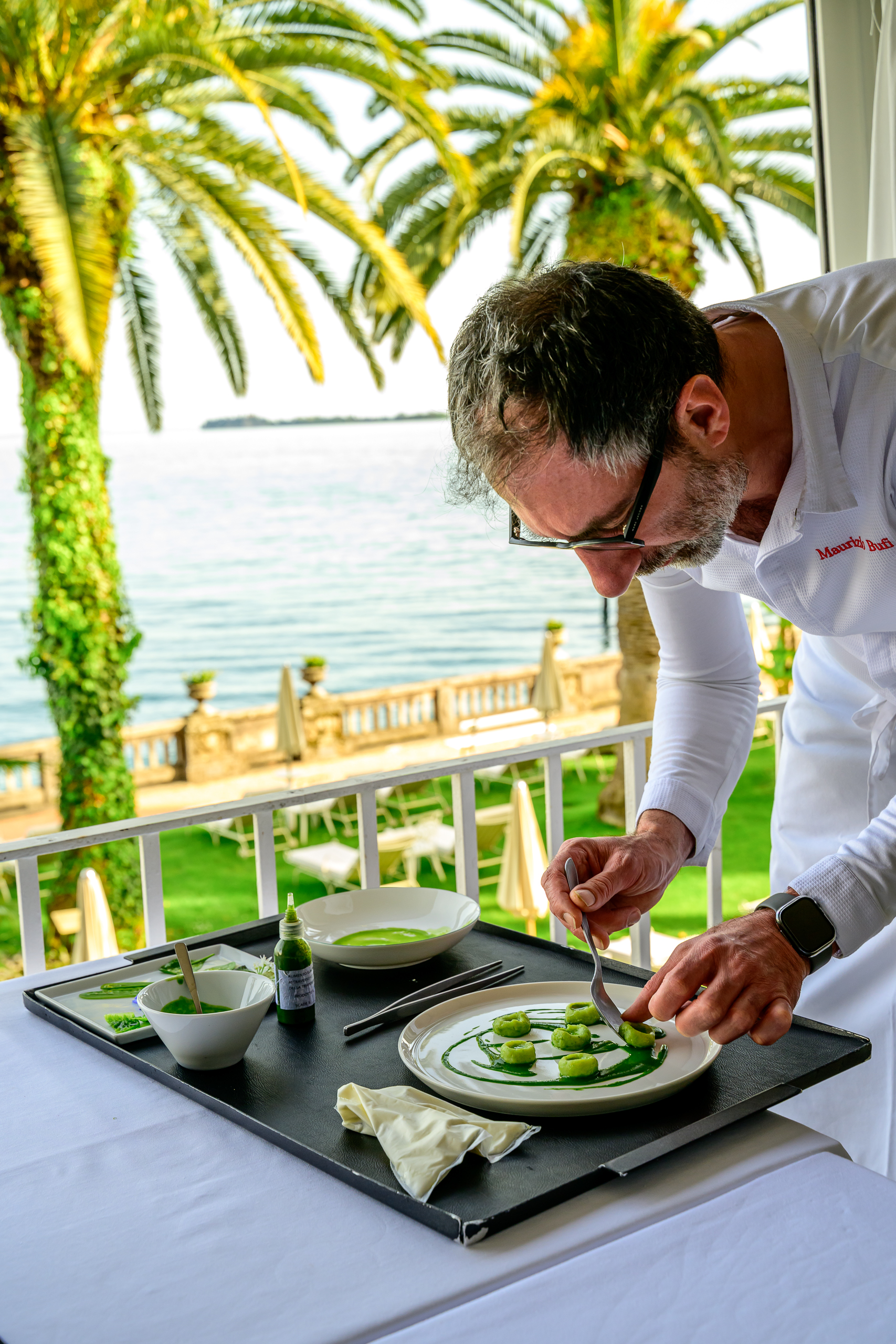
Maurizio Bufi with Dumplings “GREEN”
When are you happiest?
I am the happiest person in the room when I can help illuminate a conversation, stimulate ideas, or simply make your moment a little more interesting. I like it when I can surprise with an unusual curiosity, a stimulating reflection, or an unexpected suggestion. And then, I love it when a conversation comes alive and becomes a true exchange, where creativity and passion emerge naturally. As in cooking, the richness often comes from the mix of elements—a dash of enthusiasm, a touch of depth, and an abundant dose of authenticity.
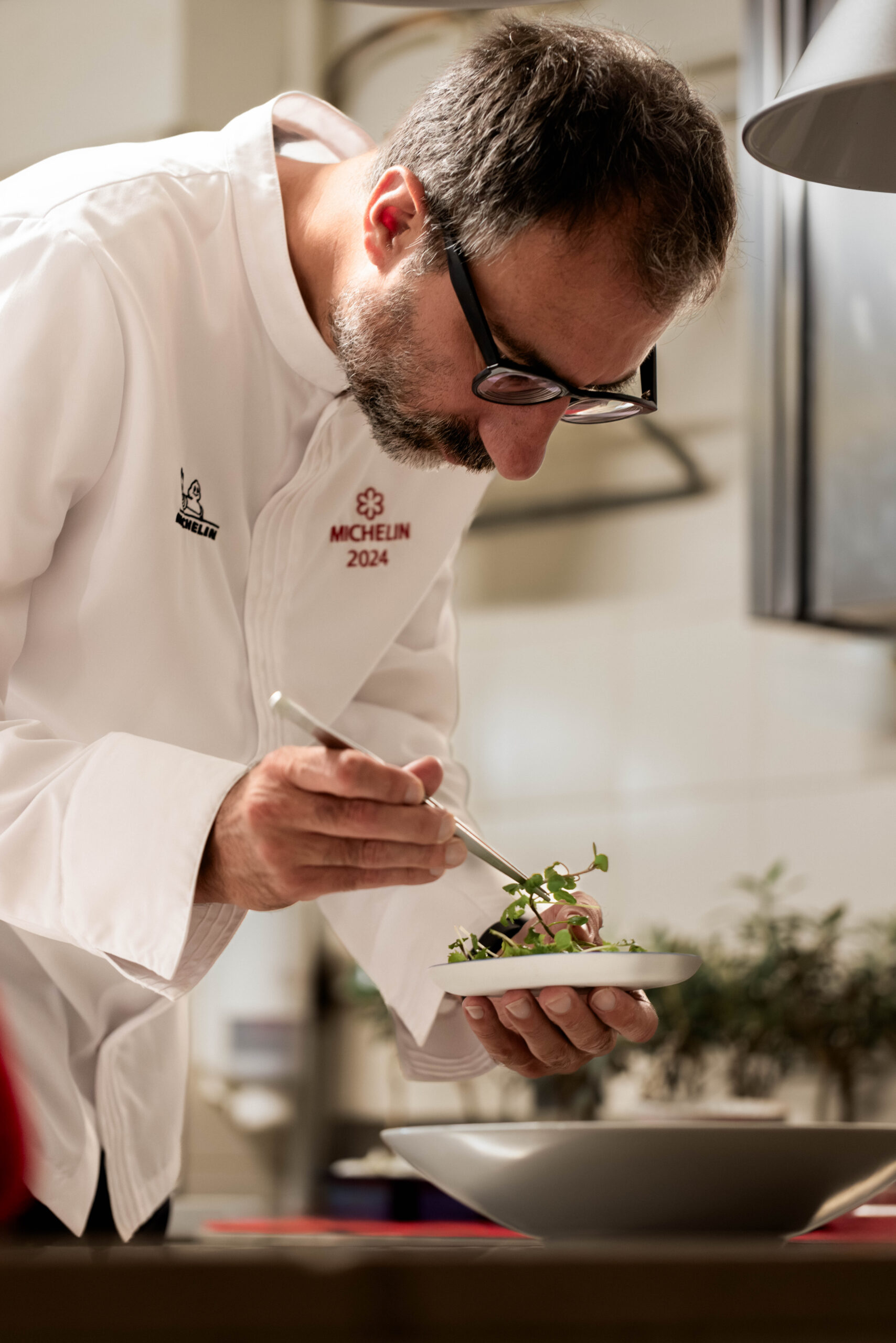
When you’re not in the kitchen where can you be found?
For me, the kitchen is a place of contemplation where I spend most of my day, in my free time I love to go to markets, build relationships with local producers and discover new culinary connections, and it’s where new ideas and new lifestyles are born. For the rest of the time, I love to spend moments of relaxation at home or by the sea with my partner.

Calamari, sweetbreads and cashews (part 1 of 2)
Where is your favourite place to dine?
I would probably choose places that offer authenticity, quality of ingredients, and an atmosphere capable of inspiring new ideas. It could be a hidden trattoria with recipes handed down through generations, or a small bistro where the chef experiments audaciously with passion. Even a food market with stalls serving fresh and traditional dishes could be the perfect place—where energy, aromas, and flavours create an unforgettable experience.

Mackerel, razor clam, sea urchin and daikon (part 1 of 2)
What’s your favourite takeaway or comfort food?
My favourite comfort food could be something simple but incredibly satisfying. A warm plate of ramen, where every sip offers comfort and depth of flavour. Or a good pizza, which can always be a valid excuse for pizza—crispy, tasty, and always a certainty—or maybe a good artisan burger with fresh and balanced ingredients. Ultimately, comfort food is what makes you feel good, that hugs or cradles you with every bite.
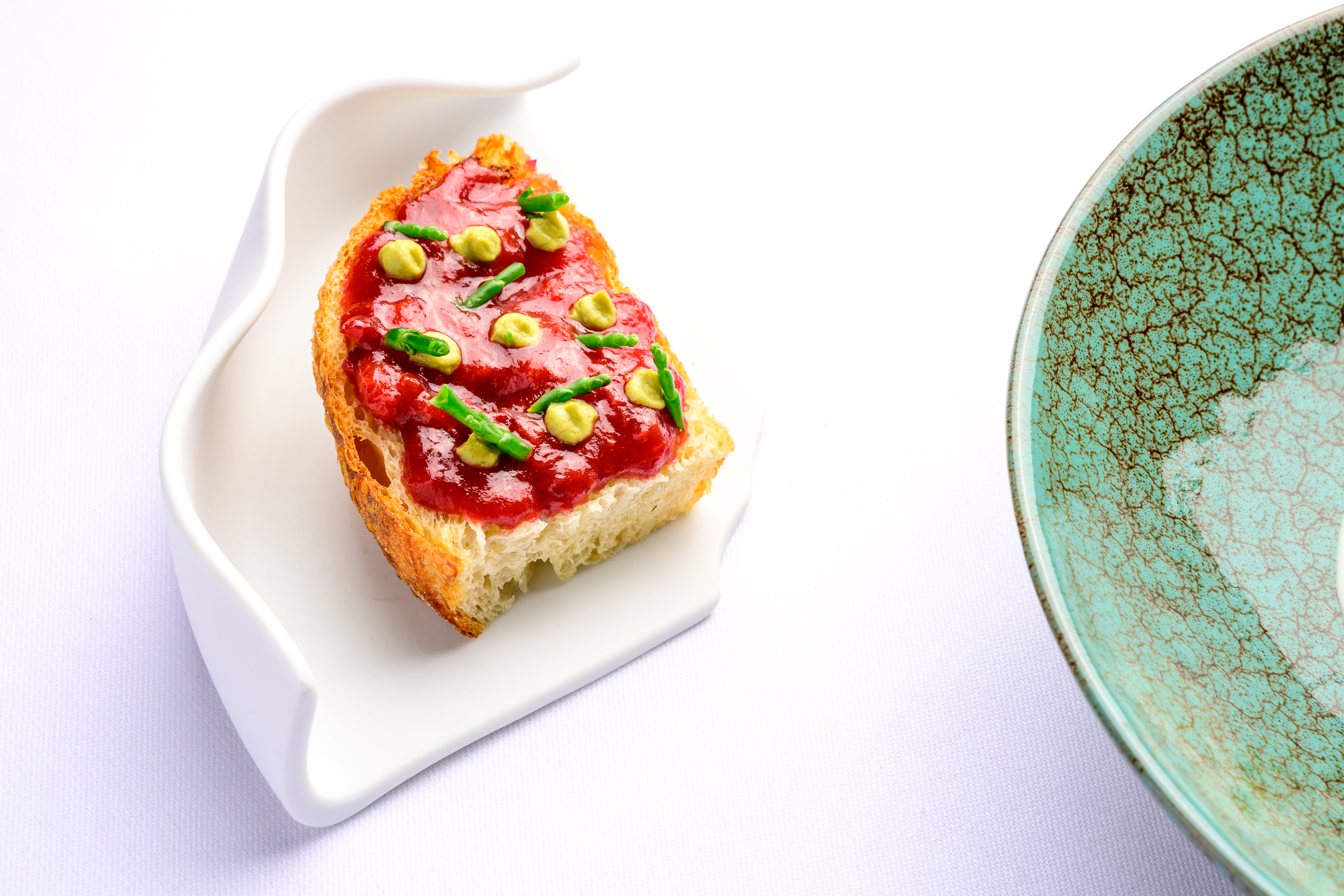
Mackerel, razor clam, sea urchin and daikon (part 1 of 2)
What makes the local food scene so exciting?
The local culinary scene is truly enchanting because it strikes a perfect balance between tradition and innovation. There are authentic experts who recount stories of generations, local ingredients that express the identity of a territory, and chefs who reinvent classic dishes with a modern touch. Every market, trattoria, and restaurant contribute to creating a mosaic of unparalleled gastronomic excellence. Furthermore, the energy of the local culinary scene is fuelled by the passion for quality and the desire to experiment. Food events, collaborations between chefs, and the rediscovery of artisan techniques make the panorama complete and vibrant. It’s a continuous source of excellence, which is reflected in the flavours and the atmosphere of the places themselves.

Sole, asparagus and truffle
Which is the dish you’ve created that you are most proud of and why?
My mind likes to experiment at any moment, to occupy my mind with positive culinary thoughts, relationships are my boys in the kitchen, and I also draw inspiration from their ideas and thoughts, in fact I try to maintain firm my initial principles of a philosophy that respects the past and looks to the future, where some dishes are born and over time they mutate into version 2.0, and sometimes they change completely. My favourite animal-friendly and ancestral dishes, the cutlet and lucio, pigeon pear and lampascioni, bread and chocolate, butter and liquorice risotto, are signature dishes.
You’re having friends over for dinner tonight. What’s on the table?
If I had friends over for dinner, I would imagine a table full of colours, aromas and flavours that invite conviviality. It could be a super mix of tomato and basil bruschetta, accompanied by a selection of cheeses and cold cuts. For the main course, perhaps a homemade pasta with a rich and enveloping sauce, or a roast that cooks slowly, releasing irresistible aromas. And of course, don’t forget dessert—maybe a creamy tiramisu or a fruit tart. All accompanied by a good wine and lots of pleasant conversation.
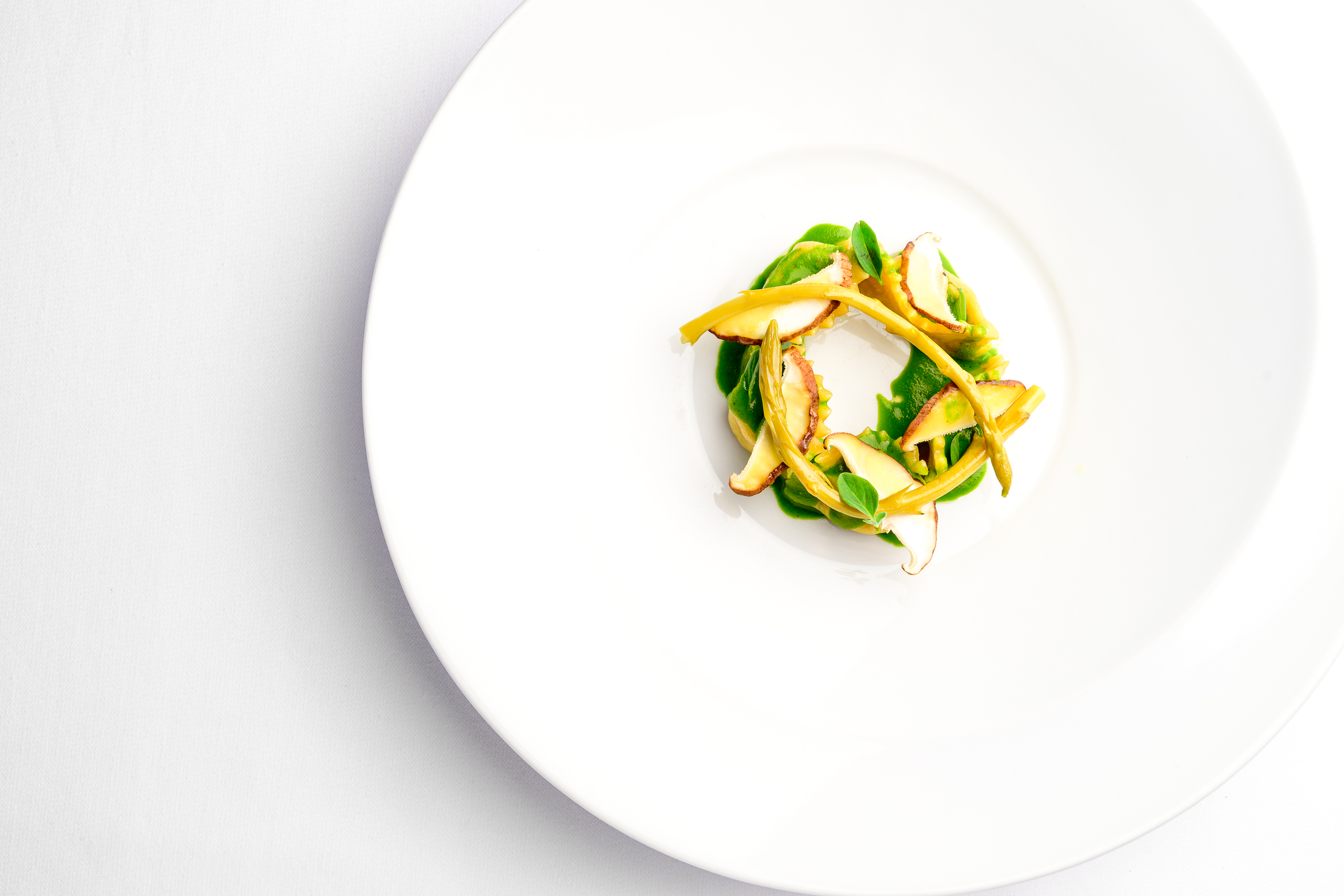
Rabbit plin, shiitake mushrooms and barley miso
Name your favourite city that has it all: food, culture, and nightlife.
There are many cities in the world that offer an extraordinary mix of daytime and nighttime life. A place that could encapsulate all of this is Barcelona, with its Mediterranean soul, vibrant markets like La Boqueria, Parc de Gaudí, and the nocturnal energy that ranges from local clubs to the beach. Or Tokyo, where every corner reveals a culinary discovery, from sushi bars to innovative restaurants. Immerse yourself in a city that pulses with culture and unique experiences, even after sunset.
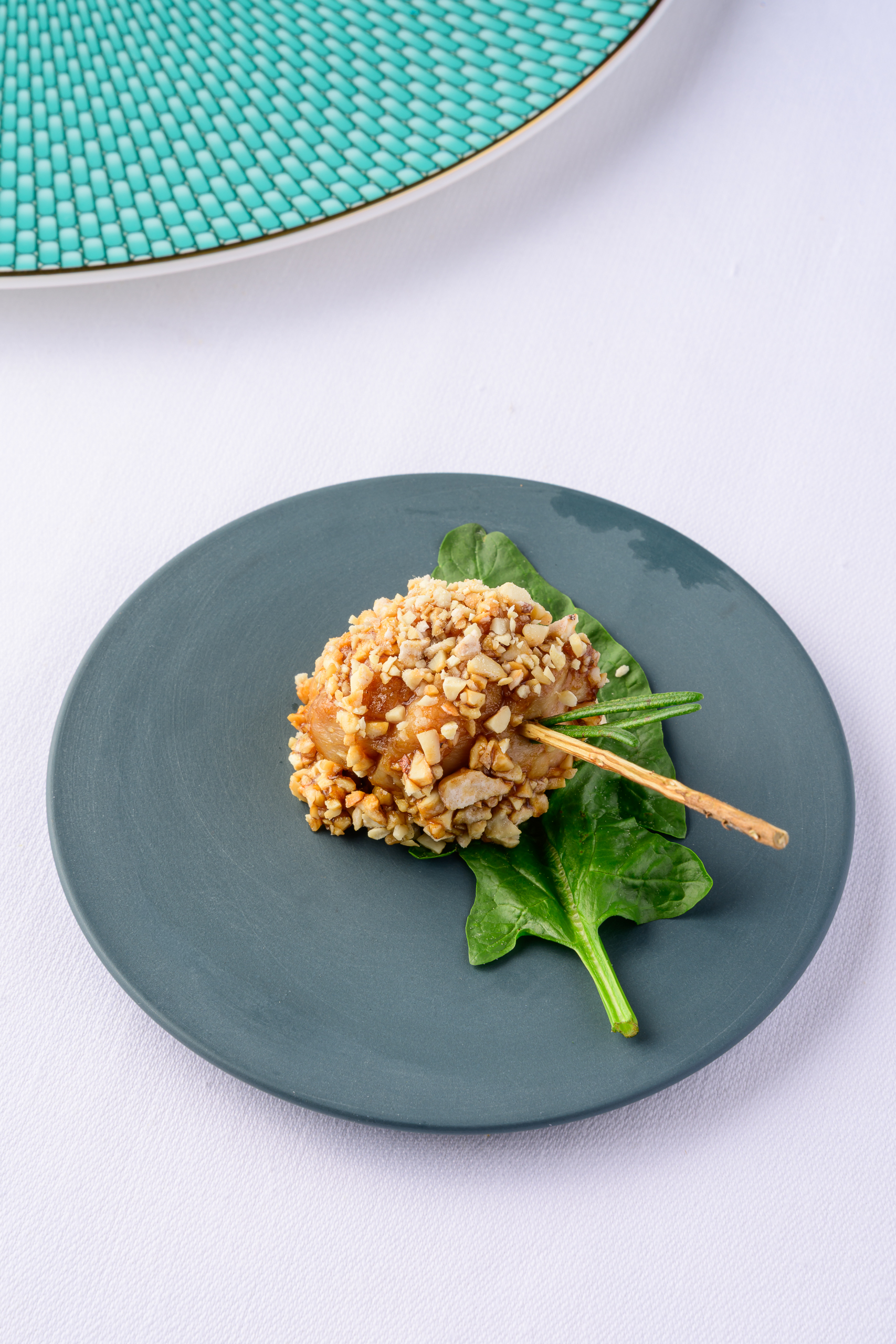
Calamari, sweetbreads and cashews (part 2 of 2)
Can you tell us more about the cuisine at your restaurants?
If I were a chef with restaurants, my cuisine would reflect a perfect balance between tradition and creativity. Every dish would be conceived to enhance seasonal and local ingredients, respecting the roots of gastronomy but with an innovative touch. It could be a modern cuisine that celebrates genuine flavours, with classic techniques enhanced by contemporary interpretations.

Imagine a menu where simplicity meets refinement: appetizers that tell the story of the territory, first courses that express passion and attention to detail, second courses that enhance the quality of the raw material. And, of course, desserts that conclude the experience with an unforgettable memory.
Recipe of Cartellata :
Ingredients :
• 150 gr 00 flour
• 50 gr re-milled durum wheat semolina
• 2 egg yolks
• 1 whole egg
INGREDIENTS FOR THE CREAMED PIKE:
• 200 gr pike fillet
• 30 gr white onion
• 20 gr shallot
• 1 clove garlic
• 200 ml vegetable cream
• 50 gr extra virgin olive oil
• Salt
• White pepper
• 1 bay leaf
• 1/2 grated lemon zest
• 2 sprigs of thyme
• 2 sprigs of rosemary
GREEN LEEK OIL:
• 50 gr seed oil
• 15 gr parsley leaves
• 15 gr leek green part
FOR THE SMOKED POTATO FOAM:
• 200 gr potatoes
• 200 gr vegetable milk
• Salt, white pepper
• Olive wood chips for smoking
PLATE FINISHING ELEMENTS:
• Caper powder
• 12 brined caper leaves
• 12 dehydrated Taggiasca olives
• Candied lemon
• Fresh oregano leaves
Preparation:
• FOR THE CREAMED PIKE: Take the pike fillet and place it in a vacuum bag with bay leaf, garlic, thyme, rosemary inside, and cook it sous vide at 58°C for 4 hours. Afterwards, remove the pike from the bag, keeping aside the cooking liquid which will be useful later. Clean the pike, removing all bones, and set aside. In a stainless steel pot, add olive oil, chopped onion, and shallot, let them brown over heat, then add the pike fillet. Let it stew for a few minutes, then add the cooking liquid and vegetable cream. Cook until it has completely broken down and absorbed part of the liquids. Once cold, transfer the pike to a stand mixer and begin creaming it, adding olive oil in a steady stream. Once creamed, finish with salt, pepper, grated lemon zest, and set aside.
• FOR THE GREEN LEEK OIL: Wash and pick the parsley leaves, cut the green part of the leek. In a blender, combine the seed oil, well-dried parsley, and well-dried leek. Blend for 3 minutes. Transfer the mixture to a pot and bring to the heat where it should reach 100°C. Strain everything through a fine sieve and recover only the oil. Immediately place it in the refrigerator to preserve its brightness.
• FOR THE SMOKED POTATO FOAM: Boil the potatoes in salted water, cut them into pieces and transfer them to a bowl. Begin smoking for 20 minutes using a smoking gun and olive wood chips. Transfer the smoked potatoes to a Thermomix and add the hot vegetable milk. Blend for 3 minutes at maximum power. Adjust salt and pepper and transfer the mixture to a siphon, adding the first charge. Let the foam rest, and then, after 3 hours or before service, insert the second charge. Keep the siphon in a bain-marie during service.
• FOR THE CARTELLATA: In a mixer, add the flours and eggs. Knead everything until you obtain a homogeneous and not too wet dough. Roll out the dough using a pasta machine. With the help of a fluted wheel, cut strips 2 cm high and 25 cm long. Pinch the ends and then start twisting inwards to form a perfect circle. Place the cartellate in the fridge, ready for cooking.
• FINISHING AND PRESENTATION: Cook the cartellate in salted water. Place the potato foam at the bottom of the plate. Lay the cartellata on top and begin filling the internal spaces with the creamed pike. Alternate with caper leaves, dehydrated olives, caper powder, candied lemon. Finish with green leek oil and fresh oregano leaves.


